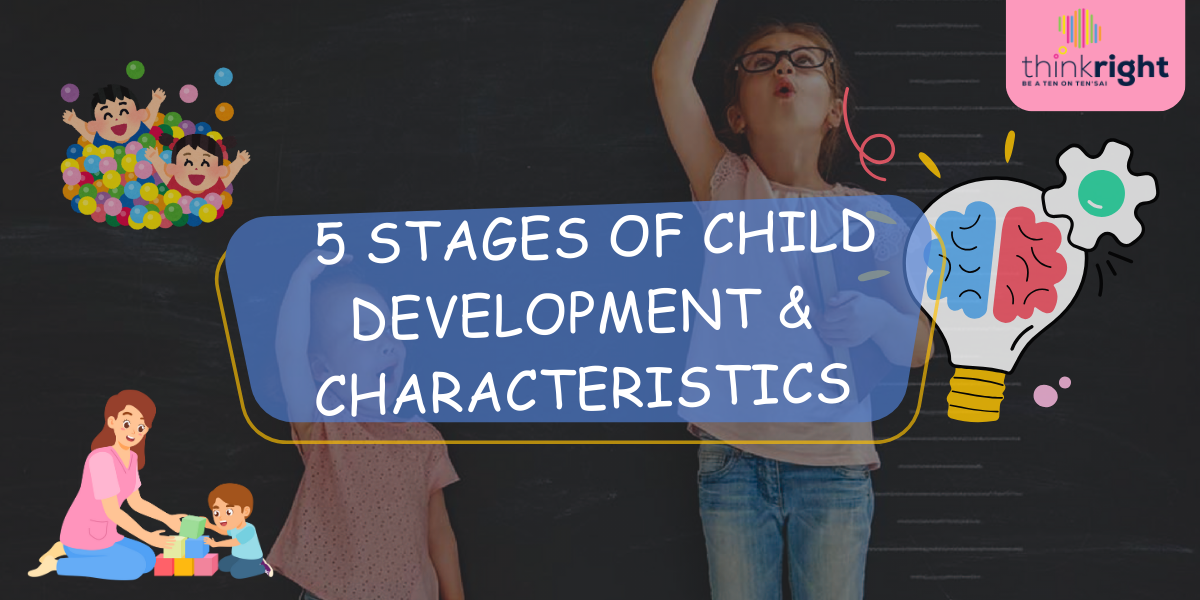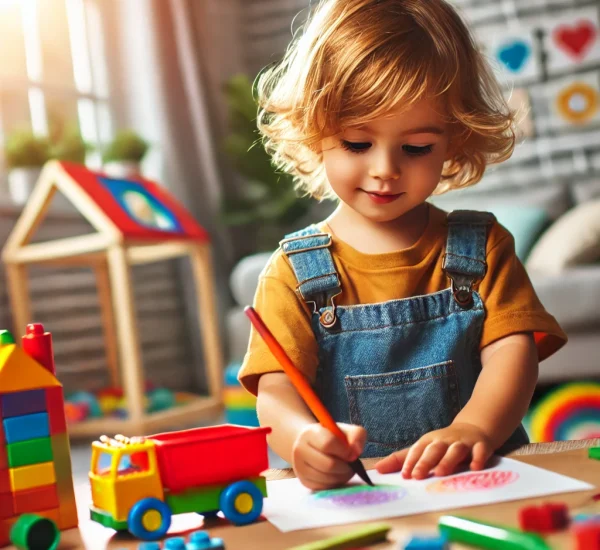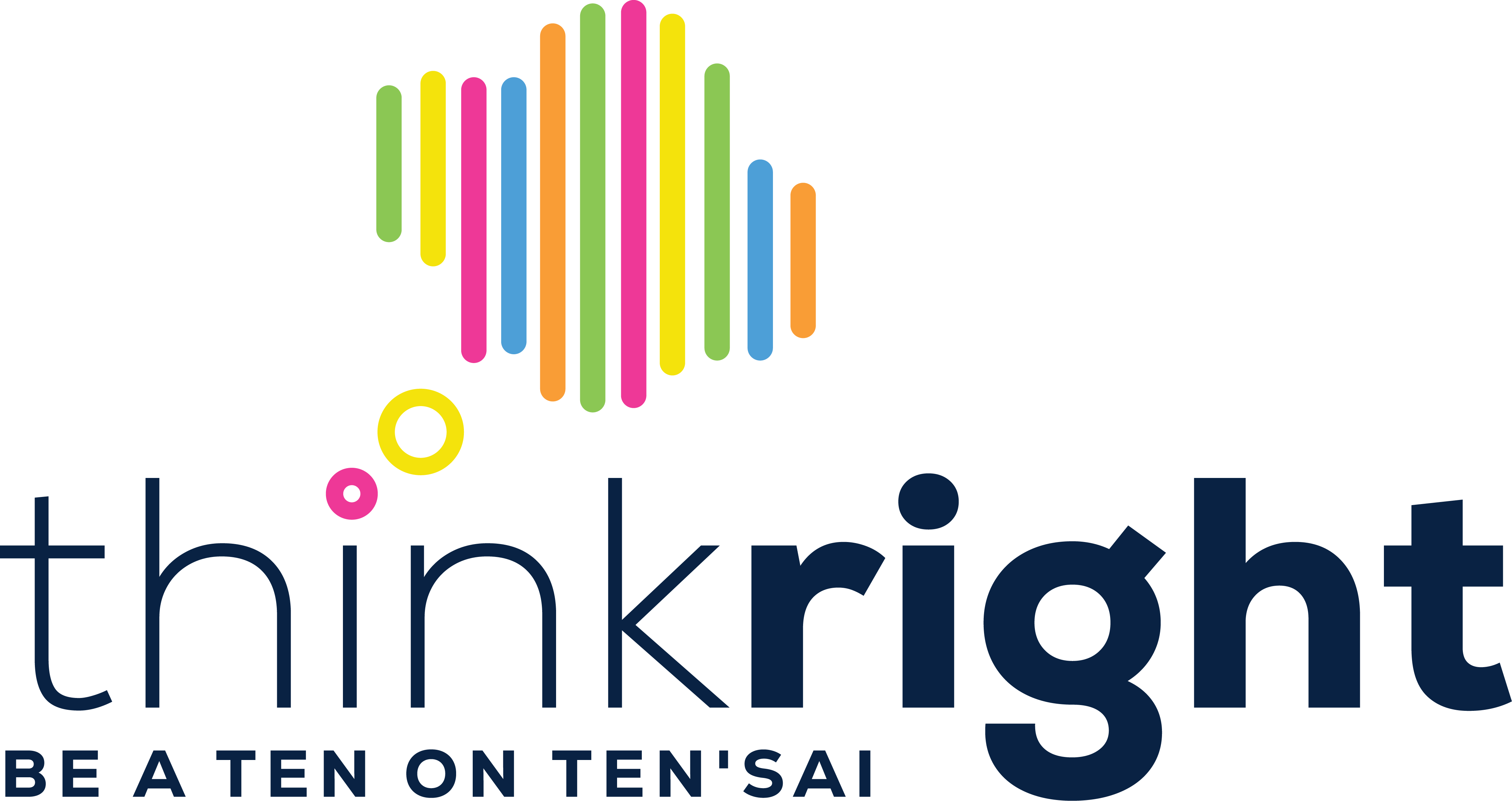
Five Stages of Child Development & Characteristics: A Complete Guide by ThinkRight
Child development is a dynamic and continuous process that occurs in distinct stages. Each stage is characterized by specific physical, cognitive, emotional, and social milestones that shape a child’s growth. Understanding these 5 stages of child development can help parents, caregivers, and educators provide the necessary support for a child’s overall development.
At ThinkRight, we specialize in Right Brain Education and Early Childhood Development Courses designed to enhance cognitive abilities, boost creativity, and strengthen problem-solving skills in children. In this blog, we will explore the Five stages of child development & characteristic, their key characteristics, and how parents can support their child’s growth during each phase.
What Are the Five stages of child development & characteristic ?
The five primary stages of child development include:
Infancy (0-2 Years) – The Sensorimotor Stage
Early Childhood (2-6 Years) – The Preoperational Stage
Middle Childhood (6-12 Years) – The Concrete Operational Stage
Adolescence (12-18 Years) – The Formal Operational Stage
Young Adulthood (18-25 Years) – The Transitional Stage
Each of these stages is essential for shaping a child’s personality, intelligence, and emotional well-being. Let’s take a closer look at these phases and their defining characteristics.
Frequently Asked Questions (FAQs)
1. Why is understanding child development stages important?
Understanding these stages helps parents provide age-appropriate learning opportunities and emotional support for their child’s growth.
2. How does ThinkRight help with child development?
We offer Right Brain Education programs that focus on memory training, problem-solving, creativity, and emotional intelligence.
3. What activities can help in child development?
Activities like puzzles, storytelling, creative play, sports, and logic games enhance a child’s cognitive and social skills.
4. When does a child develop critical thinking skills?
Critical thinking begins in middle childhood (6-12 years) and improves during adolescence and young adulthood. Five stages of child development & characteristic.


1. Infancy (0-2 Years) – The Sensorimotor Stage
The infancy stage is the foundation of a child’s development, where rapid growth and learning occur through sensory experiences and movement.
Key Characteristics of Infancy:
✅ Sensory Exploration: Babies learn by touching, seeing, tasting, hearing, and smelling.
✅ Motor Development: Movements evolve from reflexes to intentional actions (e.g., crawling, standing, and walking).
✅ Attachment & Trust: Infants develop emotional bonds with caregivers, shaping future relationships.
How Parents Can Support This Stage:
🔹 Provide sensory-rich experiences through toys, textures, and sounds.
🔹 Engage in responsive communication by talking, singing, and reading to your baby.
🔹 Encourage safe exploration to promote motor skills and curiosity.
🔹 Build a secure attachment by being attentive and nurturing. Five stages of child development & characteristic.
2. Early Childhood (2-6 Years) – The Preoperational Stage
This stage is marked by rapid language acquisition, increased curiosity, and imaginative thinking. Children begin to develop their personality and independence.
Key Characteristics of Early Childhood:
✅ Language Explosion: Vocabulary expands, and kids start forming complete sentences.
✅ Symbolic Play & Imagination: Engaging in pretend play, drawing, and storytelling.
✅ Egocentric Thinking: Difficulty seeing things from another person’s perspective.
How Parents Can Support This Stage:
🔹 Encourage creative play with art, music, and storytelling.
🔹 Introduce brain development activities, such as puzzles and memory games (as taught at ThinkRight).
🔹 Foster social interactions through playdates and group activities.
🔹 Teach basic emotions and empathy by helping children label their feelings. Five stages of child development & characteristic.


3. Middle Childhood (6-12 Years) – The Concrete Operational Stage
During middle childhood, children develop logical thinking, academic skills, and peer relationships. They become more independent and aware of the world around them.
Key Characteristics of Middle Childhood:
✅ Logical Thinking: Ability to understand cause-and-effect relationships.
✅ Academic Growth: Improved reading, writing, and mathematical skills.
✅ Problem-Solving Skills: Developing strategies for solving challenges.
How Parents Can Support This Stage:
🔹 Provide educational activities that challenge their reasoning skills.
🔹 Encourage extracurricular activities like sports, music, and problem-solving games.
🔹 Support emotional resilience by teaching coping skills and self-confidence.
🔹 Limit screen time and promote active learning experiences.
At ThinkRight, we offer Right Brain Education programs that focus on enhancing memory, concentration, and analytical thinking, which are crucial during this stage. Five stages of child development & characteristic
4. Adolescence (12-18 Years) – The Formal Operational Stage
Adolescence is a time of rapid physical, emotional, and intellectual transformation. Teenagers develop abstract thinking, identity, and independence.
Key Characteristics of Adolescence:
✅ Abstract Thinking: Ability to understand complex ideas and hypothetical situations.
✅ Identity Formation: Exploring personal interests, values, and goals.
✅ Emotional Sensitivity: Mood swings and self-consciousness increase.
How Parents Can Support This Stage:
🔹 Encourage open communication and active listening.
🔹 Guide them in setting realistic goals for education and career paths.
🔹 Teach critical thinking skills to make informed decisions.
🔹 Support mental well-being by promoting self-care and resilience.
ThinkRight’s holistic learning approach can help teenagers enhance cognitive abilities and emotional intelligence, preparing them for future success. Five stages of child development & characteristic


5. Young Adulthood (18-25 Years) – The Transitional Stage
In this stage, individuals move towards full independence, career development, and personal responsibility.
Key Characteristics of Young Adulthood:
✅ Career Development: Making education and job-related decisions.
✅ Emotional & Social Maturity: Learning to manage relationships and responsibilities.
✅ Long-Term Planning: Setting life goals and financial independence.
How Parents Can Support This Stage:
🔹 Offer emotional support without being over-controlling.
🔹 Encourage self-reliance and financial independence.
🔹 Promote continuous learning and personal growth.
🔹 Provide guidance in career planning and decision-making.
At ThinkRight, we emphasize lifelong learning, goal setting, and self-improvement techniques to help young adults achieve their fullest potential. Five stages of child development & characteristic
Conclusion
Understanding the Five stages of child development & characteristic can help parents and educators nurture a child’s growth effectively. Each stage has unique physical, emotional, cognitive, and social milestones that shape a child’s future.
At ThinkRight, we provide specialized Right Brain Education programs that support children at every developmental stage. Our scientifically designed courses enhance cognitive abilities, boost memory retention, and strengthen creative thinking.
🚀 Want to give your child the best start in life? Visit ThinkRight today and explore our Early Childhood Development programs! 🚀
